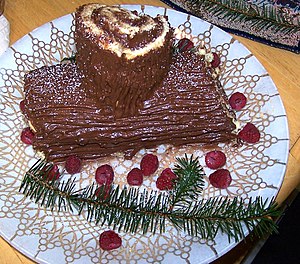Yule log (cake)

Bûche de Noël (French pronunciation: [byʃ də nɔɛl]) ("Yule log") is a traditional dessert served during the Christmas holidays in France, Belgium, Quebec, Lebanon, Vietnam, and several other Christian-populated francophone countries—and in the UK. As the name indicates, the cake is generally prepared, presented, and garnished so as to look like a log ready for the fire.
The traditional bûche is made from a Génoise or other sponge cake, generally baked in a large, shallow Swiss roll pan, frosted, rolled to form a cylinder, and frosted again on the outside. The most common combination is a basic yellow sponge cake, frosted and filled with chocolate buttercream; however, many variations on the traditional recipe exist, possibly including chocolate cakes, ganache and espresso or otherwise-flavored frostings and fillings. Bûches are often served with a portion of one end of the cake cut off and set on top of the cake or protruding from its side to resemble a chopped off branch, and bark-like texture is often produced in the buttercream for further realism. This is often done by dragging a fork through the icing. These cakes are often decorated with powdered sugar to resemble snow, tree branches, fresh berries, and mushrooms made of meringue.
They can be considered a type of sweet roulade.
References
See also
